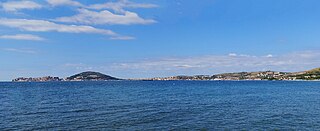
The War of the Polish Succession was a major European conflict sparked by a civil war in the Polish–Lithuanian Commonwealth over the succession to Augustus II the Strong, which the other European powers widened in pursuit of their own national interests. France and Spain, the two Bourbon powers, tested the power of the Austrian Habsburgs in Western Europe, as did the Kingdom of Prussia, whilst Saxony and Russia mobilized to support the eventual victor. The fighting in Poland–Lithuania resulted in the accession of Augustus III, who in addition to Russia and Saxony, was politically supported by the Habsburgs.

1734 (MDCCXXXIV) was a common year starting on Friday of the Gregorian calendar and a common year starting on Tuesday of the Julian calendar, the 1734th year of the Common Era (CE) and Anno Domini (AD) designations, the 734th year of the 2nd millennium, the 34th year of the 18th century, and the 5th year of the 1730s decade. As of the start of 1734, the Gregorian calendar was 11 days ahead of the Julian calendar, which remained in localized use until 1923.

Charles Edward Louis John Sylvester Maria Casimir Stuart was the elder son of James Francis Edward Stuart making him the grandson of James VII and II, and the Stuart claimant to the thrones of England, Scotland, and Ireland from 1766 as Charles III. During his lifetime, he was also known as "the Young Pretender" and "the Young Chevalier"; in popular memory, he is known as Bonnie Prince Charlie.

James FitzJames, 1st Duke of Berwick was a French Royal Army officer and nobleman who was the illegitimate son of James II of England by Arabella Churchill, the sister of John Churchill, 1st Duke of Marlborough. Berwick was a successful general in the service of Louis XIV.

Gaeta is a city in the province of Latina, in Lazio, Italy. Set on a promontory stretching towards the Gulf of Gaeta, it is 120 kilometres from Rome and 80 km (50 mi) from Naples.

The Battle of Maida, fought on 4 July 1806 was a battle between the British expeditionary force and a French force outside the town of Maida in Calabria, Italy during the Napoleonic Wars. John Stuart led 5,236 Anglo-Sicilian troops to victory over about 5,400 Franco-Italian-Polish troops under the command of French general Jean Reynier, inflicting significant losses while incurring relatively few casualties. Maida is located in the toe of Italy, about 30 kilometres (19 mi) west of Catanzaro.

The Battle of Bitonto was a Spanish victory over Austrian forces near Bitonto in the Kingdom of Naples in the War of Polish Succession. The battle ended organized Austrian resistance outside a small number of fortresses in the kingdom.

The siege of Gaeta was the concluding event of the war between the Kingdom of Sardinia and the Kingdom of the Two Sicilies, part of the unification of Italy. It started on 5 November 1860 and ended on 13 February 1861, and took place in Gaeta, in today's Southern Lazio (Italy).
The siege of Gaeta can refer to several historical sieges of the city of Gaeta in Italy:

The siege of Barcelona was a thirteen month battle at the end of the War of Spanish Succession, which pitted Archduke Charles of Austria against Philip V of Spain, backed by France in a contest for the Spanish crown.

Count Wirich Philipp von Daun was an Austrian Field Marshal of the Imperial Army in the War of Spanish Succession, and father of the better known Leopold Josef Graf Daun. In 1710 he was created Prince of Teano.

Charles Dillon, 10th Viscount Dillon (1701–1741) fought in the War of the Polish Succession for France under Berwick as colonel-proprietor of Dillon's Regiment at the Siege of Kehl in 1733 and the Siege of Philippsburg in 1734. After the armistice, he married, moved to Ireland, and succeeded his cousin Richard as the 10th Viscount Dillon.
The Treaty of Casalanza, which ended the Neapolitan War, was signed on 20 May 1815 between the Napoleonic Kingdom of Naples on the one hand and the Austrian Empire, as well as the Great Britain, on the other. The signature occurred in a patrician villa, owned by the Lanza family, in what is now the commune of Pastorano, Campania, southern Italy.
The siege of Gaeta was a three-month siege of the Italian city of Gaeta in 1707 by the forces of the Austrian monarchy under Wirich Philipp von Daun, during the War of the Spanish Succession. It ended on 30 September with the total destruction of the city's historic fortifications.

The siege of Gaeta saw the fortress city of Gaeta and its Neapolitan garrison under General Louis of Hesse-Philippsthal besieged by an Imperial French corps led by Marshal André Masséna. After a prolonged defense in which Hesse was severely wounded, Gaeta surrendered, and Masséna granted its garrison generous terms.

The siege of Philippsburg was conducted by French forces against troops of the Holy Roman Empire in the fortress of Philippsburg in the Rhine River valley during the War of the Polish Succession. The Duke of Berwick led 100,000 men up the Rhine Valley, of which 60,000 were detached to invest the fortress at Philippsburg, beginning on 26 May 1734. An Imperial relief army of 70,000 under the aging Prince Eugene of Savoy was unsuccessful in actually relieving the siege. On 12 June Berwick was killed by a cannonball while inspecting the trenches, and command of the besiegers fell to Marshals d'Asfeld and Noailles. The fortress surrendered one month later, and the garrison withdrew to the fortress of Mainz with the honours of war.
The siege of Capua was the last major military action of the War of the Polish Succession in the Kingdom of Naples. Austrian forces of the Habsburg monarchy, under the command of the Austrian Marshal Otto Ferdinand von Abensberg und Traun, withstood for seven months a blockade begun in April 1734 by Spanish and French forces under Count Marsillac. General Traun surrendered the fortress of Capua in November 1734 with full honors of war, primarily because of exhausted provisions and ammunition, but also because it was clear no relief was coming to the isolated garrison.
Events from the year 1734 in Scotland.












